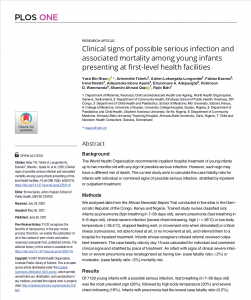
Background
The World Health Organization recommends inpatient hospital treatment of young infants up to two months old with any sign of possible serious infection. However, each sign may have a different risk of death. The current study aims to calculate the case fatality ratio for infants with individual or combined signs of possible serious infection, stratified by inpatient or outpatient treatment.
Methods
We analysed data from the African Neonatal Sepsis Trial conducted in five sites in the Democratic Republic of the Congo, Kenya and Nigeria. Trained study nurses classified sick infants as pneumonia (fast breathing in 7–59 days old), severe pneumonia (fast breathing in 0–6 days old), clinical severe infection [severe chest indrawing, high (> = 38°C) or low body temperature (<35.5°C), stopped feeding well, or movement only when stimulated] or critical illness (convulsions, not able to feed at all, or no movement at all), and referred them to a hospital for inpatient treatment. Infants whose caregivers refused referral received outpatient treatment. The case fatality ratio by day 15 was calculated for individual and combined clinical signs and stratified by place of treatment. An infant with signs of clinical severe infection or severe pneumonia was recategorised as having low- (case fatality ratio ≤2%) or moderate- (case fatality ratio >2%) mortality risk.
Results
Of 7129 young infants with a possible serious infection, fast breathing (in 7–59 days old) was the most prevalent sign (26%), followed by high body temperature (20%) and severe chest indrawing (19%). Infants with pneumonia had the lowest case fatality ratio (0.2%), followed by severe pneumonia (2.0%), clinical severe infection (2.3%) and critical illness (16.9%). Infants with clinical severe infection had a wide range of case fatality ratios for individual signs (from 0.8% to 11.0%). Infants with pneumonia had similar case fatality ratio for outpatient and inpatient treatment (0.2% vs. 0.3%, p = 0.74). Infants with clinical severe infection or severe pneumonia had a lower case fatality ratio among those who received outpatient treatment compared to inpatient treatment (1.9% vs. 6.5%, p<0.0001). We recategorised infants into low-mortality risk signs (case fatality ratio ≤2%) of clinical severe infection (high body temperature, or severe chest indrawing) or severe pneumonia and moderate-mortality risk signs (case fatality ratio >2%) (stopped feeding well, movement only when stimulated, low body temperature or multiple signs of clinical severe infection). We found that both categories had four times lower case fatality ratio when treated as outpatient than inpatient treatment, i.e., 1.0% vs. 4.0% (p<0.0001) and 5.3% vs. 22.4% (p<0.0001), respectively. In contrast, infants with signs of critical illness had nearly two times higher case fatality ratio when treated as outpatient versus inpatient treatment (21.7% vs. 12.1%, p = 0.097).